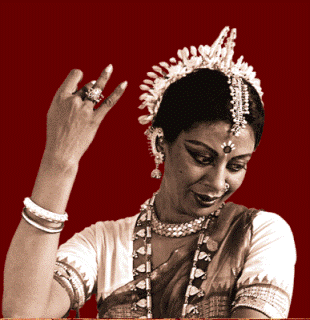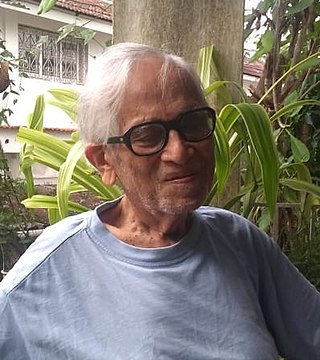
Panaji is the capital of the Indian state of Goa and the headquarters of North Goa district. Previously, it was the territorial capital of the former Portuguese India. It lies on the banks of the Mandovi river estuary in the Tiswadi sub-district (taluka). With a population of 114,759 in the metropolitan area, Panaji is Goa's largest urban agglomeration, ahead of Margao and Mormugao.

Protima Gauri Bedi (12 October 1948 – 18 August 1998) was an Indian model turned Odissi exponent. In 1990, she established Nrityagram, a dance school in Bangalore.

Nrityagram is India's first modern Gurukul for Indian classical dances and an intentional community in the form of a dance village, set up by Odissi dancer Protima Gauri in 1990. The residential school offers training in Indian classical dance forms, Odissi, Mohiniattam, Kathak, Bharatnatyam, Kuchipudi, Kathakali and Manipuri, eight hours a day, six days a week for seven years, following the ancient Guru-shishya tradition. Designed by famous Indian architect Gerard da Cunha, the community is situated near Hesaraghatta Lake 30 km from Bengaluru. Today the Nrityagram Dance Ensemble has performed across India and in many countries abroad.

Mário João Carlos do Rosário de Brito Miranda, popularly known as Mario Miranda or Mario de Miranda, was an Indian cartoonist and painter based in Loutolim in the Indian state of Goa.

The Ponte Conde de Linhares, often shortened to Ponte de Linhares is a 3.2 km (2.0 mi) long causeway connecting Ribandar to the main city of Panjim in Goa, India. It runs along the flood plains of the Mandovi River and is surrounded by various salt pans. There are ducts which act as tide controls. The Ponte Conde de Linhares was built in 1633–34 under the direction of the then Viceroy of Portuguese India, Miguel de Noronha, 4th Count of Linhares, after whom it is named. The bridge is often said to have been the longest in the world at 3.2 km (2.0 mi) when it was completed in 1634.

Reis Magos is a village located on the northern bank of the Mandovi River in Bardez, Goa, opposite to the capital city of Panjim. The village is famous for two of Goa’s famous structures; the Reis Magos Fort, and the Reis Magos Church – the first church in Bardez. "Reis Magos" is the Portuguese name for the Three Wise Men from the Bible.

Goa University is a public state research university headquartered in the city of Panaji, in the Indian state of Goa. In addition to Panaji, it has a campus in Margao, Mapusa, Ponda, Old Goa and Vasco da Gama.

School of Planning and Architecture Delhi is a higher education federal institute located in Delhi, India specializing in education and research, and serving as the national centre of excellence, in the fields of planning and architecture. The institute primarily offers undergraduate, postgraduate, doctoral and executive education programs. It forms part of the league with other two Schools of Planning and Architecture, namely SPA Bhopal and SPA Vijayawada established by the Government of India to provide quality Architecture and physical planning education.
This is a timeline of Goan history. It overlaps with the histories of other regions in South Asia, the Indian subcontinent, and colonial powers that influenced the region, including Portugal.

Maria Aurora Couto was an Indian writer and educator best known for her book Goa: A Daughter's Story and for promoting literature and ideas within Goa and beyond. She lived in the north Goan village of Aldona. In addition to her books, she wrote for newspapers and magazine, and also taught English literature at Lady Shri Ram College, Delhi and Dhempe College of Panjim. She also helped start the DD Kosambi Festival of Ideas in 2008.
The Schools of Planning and Architecture (SPAs) are centrally funded technical institutes located across India. They are a group of autonomous public institutes of higher education under Ministry of Education, Government of India. They were established with the objectives of providing quality Architecture and physical planning education. The SPAs primarily offer undergraduate, postgraduate, doctoral and executive education programmes.

Goa Medical College (GMC) is a public medical college and hospital located in Goa, India. It is one of the oldest medical colleges in Asia. The medical college is affiliated to the Goa University (GU), being its oldest unit.

Tristão de Bragança Cunha, alternatively spelled as Tristao de Braganza Cunha, popularly known as T B Cunha was a prominent Goan nationalist and anti-colonial activist from Goa. He is popularly known as the "Father of Goan nationalism", and was the organiser of the first movement to end Portuguese rule in Goa.

The Our Lady of the Immaculate Conception Church is located in Panjim, Goa, India. The Church conducts Mass every day in English, Konkani, and Portuguese.

Jindal Vijayanagar Airport, also known as Vidyanagar Airport, is a public airport serving Bellary, Hampi and Hospet in Karnataka, India. It is located between Vidyanagar Township and a steel mill owned by JSW Steel in Toranagallu. The airport was built by Jindal Vijayanagar Steel, which later changed its name to JSW Steel. It opened in 1997 and began handling commercial flights in December 2006.

JSW Group is an Indian multinational conglomerate, based in Mumbai. It is led by Sajjan Jindal and is part of the O.P. Jindal Group. The group's diverse businesses include steel, energy, infrastructure, cement, automotive and paints, across India, the United States, South America, and Africa.

Azad Maidan is a martyrs' monument and ground in the Indian state of Panaji, Goa. It is located opposite the Goa Police headquarters on the Mahatma Gandhi Road, Panaji. It is located at 15°30′0″N73°49′34″E.

Joaquim Heliodoro da Cunha Rivara was a Portuguese physician, professor, intellectual and politician. He excelled as a scholar of the history of the Portuguese presence in India and as a champion of the Konkani language.

Goa is a state on the southwestern coast of India within the Konkan region, geographically separated from the Deccan highlands by the Western Ghats. It is bound by the Indian states of Maharashtra to the north, and Karnataka to the east and south, with the Arabian Sea in the west. It is India's smallest state by area and fourth-smallest by population. Goa has the highest GDP per capita among all Indian states, two and a half times as high as the GDP per capita of the country as a whole. The Eleventh Finance Commission of India named Goa the best-placed state because of its infrastructure, and India's National Commission on Population rated it as having the best quality of life in India. It is the second-highest ranking among Indian states in the human development index.

Bruno Dias Souza is an Indian architect. He is credited with having "belonged to a generation of architects that sought to rediscover what Modern architecture meant for India" and having had an "illustrious architectural career".

















